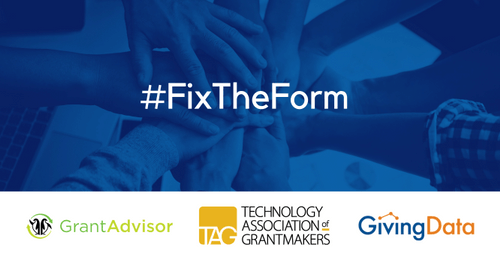
CA Budget Time Again: Small Surplus is Back But Catastrophic Needs Ahead
01.11.2025 | Linda J. Rosenthal, JD

For the nonprofit community, an important hashtag to keep an eye on is “FixTheForm.”
It’s a self-described “scrappy grassroots international movement to identify (and fix!) the top pain points in grant applications.” Why We Need to #FixTheForm (January 15, 2021) Kari Aanestad, GrantAdvisor Blog; see also Fix the Form! A Campaign to Curb the Byzantine Process of Applying for a Grant (May 19, 2021) Dawn Wolfe, Inside Philanthropy.
It’s no secret that grantseeking nonprofits have long simmered about the mind-numbing obstacle courses they are obliged to traverse for the privilege of applying for even tiny grant awards.
Among the most vocal critics urging reform has been blogger extraordinaire Vu Le, seasoned nonprofit executive and commentator. In his prolific writings at NonprofitAF.com (@nonprofitaf), he has taken aim at a long list of unnecessarily time-consuming, one-sided, and tone-deaf funder practices. See, for example, 10 archaic and harmful funding practices we can no longer put up with (March 29, 2020); #CrappyFundingPractices and why we need to name and shame more often (April 25, 2021); and We need to have a serious talk about character limits on grant applications (August 15, 2021). Of course, he is generous with praise where appropriate; see 9 examples of funders being awesome partners to nonprofits (August 6, 2018).
As it happens, Vu Le is a big fan of the online site, GrantAdvisor, created a few years ago as a pilot program. GrantAdvisor.org, a site for reviewing foundations, and why all the cool people are using it (August 28, 2017) Vu Le, Nonprofit AF Blog. He participated in developing this “joint effort between nonprofits and foundations.”
The sponsoring organizations created the site because they “believe that grantseekers and grantmakers need each other to succeed” in their work, and that “[t]ransparency and trust-based philanthropy are foundational to lasting change and an equitable future.”
The current GrantAdvisor “About” page describes the site as “a safe way to anonymously give and receive feedback on grantmaking. Nowhere else can grantseekers find public advice from peers on what it really takes to secure grant funding or where foundations can get free, honest feedback.”
Vu Le more colorfully describes GrantAdvisor’s origins and purpose: “It’s like TripAdvisor or Yelp, but for reviewing foundations. Anyone can provide a review, and when a foundation has five reviews, its profile will go live so everyone can see all the reviews. It’s anonymous, so you can be honest.”
Mr. Le highlights the benefits that flow to both grantmakers and grant seekers. “It’ll help foundations to get no-BS feedback and advice that they might not be able to get otherwise. And it’ll help us nonprofits not waste our time with foundations that have consistently horrible reviews; we have important things to do, like saving the world.”
Successful since its early pilot days, GrantAdvisor has accumulated lots of helpful reviews in the ensuing few years. By the fall of 2020, the site’s Co-Director, Kari Aanestad, who also happens to be Director of Advancement at the Minnesota Council of Nonprofits, teamed up with the U.K’s Laura Solomons. Using feedback from some 2,500 reviews of foundations, they wanted to follow-up on preliminary indications that “small (but impactful) changes to online grant applications” might “represent the top opportunity for improvement” in the grant making field.
So Ms. Aanestad and Ms. Solomons launched a survey in November 2020 to “more clearly identify the specific changes the grantmaking community is calling for.” Within four weeks, there were 500 responses from diverse organizations (“every shape, size, and activity area of the nonprofit sector”) from nine nations.
By late spring 2021, they had identified and decided to tackle the “No. 1 pain point they heard from fundraisers.”
The #FixTheForm Campaign “seeks to end the maddeningly common practice of making it impossible to view entire grant applications in advance of applying. It’s a seemingly small adjustment, but would ease what is clearly a serious hassle for applicants.”
Partnering with the Technology Association of Grantmakers (TAG) and PEAK Grantmaking, Kari Aanestad and Laura Solomons took the first step in the overall #FixTheForm movement. They launched “100 Forms in 100 Days,” asking participating funders to make their entire grant applications accessible on their websites and on GrantAdvisor.org. The organizers hoped that at least 100 funders would respond by July 2021.
Already in mid-May, some 32 foundations had joined in, including the Ford, Kresge and Charles Stewart Mott Foundations. Other participants coming on board include Microsoft and “a spectrum of family, community and other funders.”
“By the 100th day, the response to their outreach had exceeded expectations, reaching more than 3,000 grantmakers and one million NGOs worldwide. In all, 133 forms were contributed by 128 foundations, encompassing more than 6,000 questions.” What’s Next for #FixTheForm? (September 1, 2021) Roberto Cremonini, GivingData.com Blog.
The “FixTheForm” movement is “part of a larger, longer-running push in the sector to make grant funding more accessible to all by making the application process less of a drain on nonprofits, which often have limited staff time and budgets.”
A project already started is analyzing the posted grant application forms to “better understand the degree to which the broader field might already have a common grant application. A “similarity analysis” shows that some 39% of the questions are “alike.” Standardizing the application format would certainly be a welcome change for grant seekers.
— Linda J. Rosenthal, J.D., FPLG Information & Research Director
